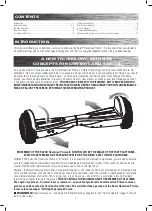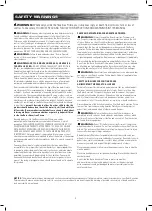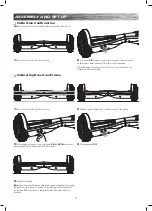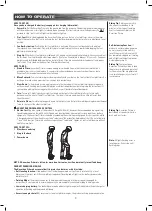
HOW TO OPERATE
Need Help?
Visit our website for replacement parts, product support, a list of authorized service centers in the US and customer service contact information
at
www.razor.com
. Please have the product I.D. code (located on the white label of your product) available for better assistance. Additional Customer
Service contact information is listed at the back of this manual.
7
HOW IT WORKS
The Hovertrax Prizma responds to the rider’s foot movements. Remember this. The Hovertrax Prizma moves due to
fore and aft foot platform tilt caused by the rider’s foot (or feet).
Movement, speed, and stopping are controlled by the degree to which the rider’s feet cause the foot platforms of the
Hovertrax Prizma to no longer be parallel to the ground.
When the product is
“ON”
, the gyroscopic mechanized balancing feature of the Hovertrax Prizma tries to keep the
foot platforms of the product parallel to the ground. In use, Hovertrax Prizma then detects changes from “level”
which are caused by fore and aft pressure on the foot platform(s) applied by the rider’s feet. Such changes are
interpreted by the Hovertrax Prizma as instructions to make the wheels move. Hovertrax Prizma tries to re-level a
forward tilt by accelerating, and tries to level a rearward tilt by decelerating.
PERIODIC RECALIBRATION IS RECOMMENDED
The Hovertrax Prizma self-balancing features are calibrated to function with a detected “resting position” that is
level. Over time and usage, recalibration may be needed to assure “level” status. If inaccurate calibration persists,
this could affect the operation of the unit by sending instructions to the motor(s) to move that may differ from the
intended motion.
To calibrate the product (see page 5 for additional information):
• Turn power OFF.
• Manually adjust the platforms so they are parallel to the ground.
• Turn power ON and HOLD until it beeps and lights flash (approximately 15-20 seconds).
• Turn power back OFF.
• Calibration complete.
Once the product has been calibrated, no matter what position (angle) the platforms are in when it is turned off, the
platforms will automatically self-balance themselves back to the calibrated position when turned on.
MOVING AND CHANGING DIRECTION:
When a rider stands on the Hovertrax Prizma with an evenly weighted foot that is “level” on either foot platform:
• Pressing toes on both feet downward moves Hovertrax Prizma forward
• Pressing heels on both feet downward moves Hovertrax Prizma backward
• Turns are done by putting more downward pressure on the front side of the foot platform on the outside of
the turn.
• A rider can spin in place by pushing downward on the front edge of one foot platform while simultaneously
pushing downward on the rear edge of the other foot platform.
ACCELERATING AND STOPPING:
• To go faster or to slow down, press the foot platforms at a greater angle for “more” and reduce the angles
for “less”.
• When slowing or stopping, if you continue to apply force to the edges opposite the direction of travel, you may not
only stop but continue on to reverse your direction.
How does this happen? The fundamental principle is that the Hovertrax Prizma is designed to be “at rest” when the
foot platforms are level – and the gyroscopic mechanized balancing feature detects the “levelness” of the product.
This same feature detects foot movements that cause a foot platform to no longer be “level” and it interprets these
changes as orders to move.
That’s it. That’s how it works. It does what your feet tell it to do, and the product “self-balances” itself in order to be
ready to detect and implement the instructions provided by a rider’s feet.
Understanding this principle is important for obvious reasons. It also suggests some obvious warnings for riding the
Hovertrax Prizma, such as:
•
Do not jump up and down on it:
If you remove a foot (or both feet), then land back on the Hovertrax Prizma and
cause the foot platform(s) to change position relative to “level” in any degree, the machine could and will react by
moving immediately in response to an “instruction”, which can result in loss of rider stability, balance or control.
•
Shifting Weight Alone is not the Issue:
Do not presume that shifting weight alone controls motion – or, for
that matter, that not shifting weight equals “stability”. Shifting of rider weight may be associated with increase
or decrease of foot pressures on the foot platforms, but it is the action of the feet on the foot platforms which
instructs Hovertrax Prizma to move. Conversely, if you were to shift your weight without altering the placement or
angle of your feet, so that the foot platforms remain level, the Hovertrax Prizma does not receive any “signal” to
interpret.
Note:
Do not lift the Hovertrax
Prizma off the ground when it
is turned on. Do not turn on the
Hovertrax Prizma in mid-air.
Riding Tip:
Certainly the rider may
"lean" on the Hovertrax Prizma,
but leaning only affects the foot
platform's position to the extent
the rider's feet change their
position. If the rider's ankles are
held at a consistent 90° angle,
leaning will result in tilting. Note
that leaning can exaggerate shifting
of weight, which may affect the
ability of a rider to recover to a level
posture – increasing the possibility
of loss of balance.


















